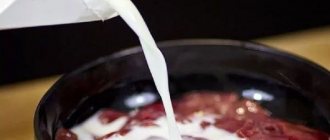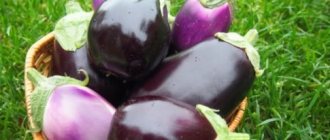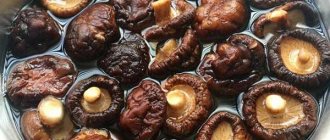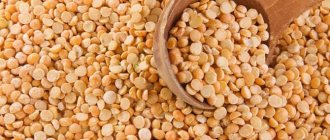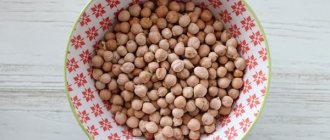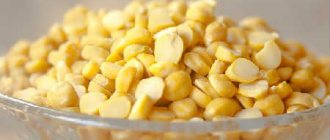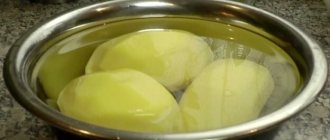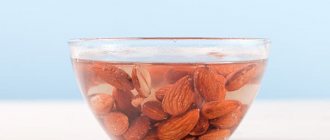Dark-fruited nightshade, also known as eggplant, is loved by many as a snack or side dish. But before cooking, it is often necessary to remove the bitterness from eggplants before frying - after all, the freshest young fruits do not always end up in our grocery basket. There are several methods that housewives and professional chefs use. We have selected 7 of the most effective ones for you.
Method 1 - using boiling water
Fresh eggplants grown on your own plot with sufficient watering and good care do not need to be processed before frying. You just need to wash and cut them. But if the vegetables were bought at the market or supermarket, there is a chance that they already have a bitter taste. It is concentrated in the peel and pulp while the eggplant is being transported and lying on the shelf.
To rid a product of bitterness using boiling water, you need to:
- cut the pulp into cubes;
- place in a colander;
- Dip into boiling salted water for 2 minutes;
- remove from the water and let it drain;
- then cook according to the recipe.
Boiling water helps remove the taste very quickly, but this technique is not suitable for all recipes. It is recommended to use it only for those dishes in which the shape of the cut is not particularly important. There is no need to prepare vegetables in advance in this way - such processing is suitable immediately before cooking.
Why and how to soak eggplants? Useful tips
Eggplant is a common vegetable, but not everyone’s favorite. This is probably due to its taste characteristics. Dishes made from bluefish can be called somewhat savory. And all because of the tart and somewhat bitter taste. Therefore, it is believed that eggplants need to be soaked before cooking. But is it really necessary to do this? It turns out that the reason lies in the “age” of the fruit and the variety. Let's take a closer look at why and how to soak eggplants. Perhaps this article will help you take a different look at generally accepted culinary habits or change them somewhat.
Reasons for the unusual taste. Why and how to soak eggplants?
Do you know that it turns out that not all fruits taste so piquant? Even before cooking begins, you can determine whether they will be bitter.
Firstly, it depends on the degree of ripeness of the eggplants. Young blues usually do not have tart “shades”. And if you grow them at home, then this is a guarantee of getting an excellent-tasting vegetable. After all, on your own plot, all garden work (fertilizing, weeding, harvesting) is carried out as expected. It is especially important to water the blue ones on time. By absorbing water, they become saturated with moisture and become very pleasant to the taste in cooked dishes. In mass cultivation, this rule is not always observed. In addition, the harvest is not carried out very regularly, so large fruits with hard brown veins and dense pulp come across.
How to choose the right eggplants
The correct choice of eggplants is an important stage in the preparation of any dish, because depending on how blue they look and how they feel, the degree of their bitterness differs. It is not the pulp that is bitter, but the skin of nightshades, because it contains a special substance - solanine. In large quantities, this element can be harmful to humans and can cause poisoning or disease. Immediately after eggplants are picked from the garden, they have virtually no bitterness. After lying on the counter for a considerable time, a large amount of solanine is produced. How to choose eggplants without bitterness:
- Give preference to young fruits. If you can buy fresh eggplants at the market, take them. You can cook vegetables immediately after harvesting without using special methods to remove the bitterness - it won’t be there.
- Examine the stalk of the blue ones. It should be elastic, and the leaves adjacent to the vegetable should be green and alive. Avoid eggplants with dry leaves.
- Choose blue ones with a smooth surface; it should squeak slightly when you run your finger over it. Avoid eggplants with slippery skin.
- Do not take huge soft vegetables - they contain a lot of solanine. These are the old blue ones.
- The darker the skin, the better. These foods contain the highest amount of antioxidants.
- How to protect yourself from coronavirus after walking
- Pizza with mushrooms recipe with photos step by step
- Russia changes entry rules into the country
The benefits and harms of blue ones
Eggplant is a healthy product that can become an important part of a person’s balanced diet. Nightshades contain many beneficial vitamins and microelements necessary for the body. For example, they contain vitamins C, B, PP, substances such as magnesium, calcium, pectin, potassium, phosphorus, iron, sodium, and fiber. Useful properties of blue:
- Helps cope with cigarette addiction. Thanks to vitamin PP or nicotinic acid, the absence of cigarettes will be much easier to bear.
- Promotes weight loss. The low calorie content of blueberries and their vitamin-rich composition make them an indispensable product in the diet of those losing weight.
- Removes toxins and excess liquid. This happens thanks to the fiber contained in vegetables.
- Stimulates digestion and removes cholesterol. This is facilitated by the pectin content in nightshades.
The only harm that blue organisms can cause is associated with the solanine content in the skin of the vegetable crop. This alkaloid in large quantities can become poisonous, causing poisoning, accompanied by the following symptoms - nausea, vomiting, fatigue, fever, general malaise. Solanine is mainly found in old fruits. Milk, egg whites, and mucous soups will help neutralize the alkaloid after poisoning.
Method 2 - in salt water
You can soak eggplants in salt whole or in pieces. To prepare a saline solution, use 1 liter of cold drinking water and 1 tablespoon of salt.
It takes at least two hours for the bitterness to leave the whole fruit. It goes away from the pieces in about 30 minutes.
How to do this correctly?
- Wash eggplants well before cooking.
- Each is cut into round or longitudinal slices, cubes or in another way specified in the recipe.
- Place in a bowl of salted water.
- Press down from above with pressure so that they do not float up.
- Then rinse with fresh water and place on a towel to remove excess moisture.
We recommend: Why you shouldn’t pour water out from under pasta - analysis of life hacks from the Internet
Changes in the properties of frozen fish during storage
Physicochemical characteristics
Physicochemical changes include shrinkage, changes in color and histological structure.
When storing frozen fish, there is always a difference in water vapor pressure above the surface of the fish and the surrounding air environment of the refrigeration room. The pressure difference causes the evaporation of moisture from the surface of the fish and, as a consequence, its movement from the inner layers of the fish to the surface, i.e. internal diffusion. This difference can be reduced by lowering the storage temperature and increasing the relative humidity.
As a result of the evaporation of moisture, the fish shrinks, which depends on its type and chemical composition, properties and size, type of packaging, temperature and duration of storage, method of stowage and location in the chamber or hold, cooling system, refrigeration room, degree of loading, amount of heat inflow etc. The surface of the fish and nearby layers of muscle tissue are mainly subjected to shrinkage.
The color of fish meat dehydrated during refrigerated storage changes. It becomes spongy, and after thawing and cooking it becomes dry and fibrous.
The amount of shrinkage depends on the chemical composition of the fish: the more moisture the fish contains, the more it can evaporate, so shrinkage is greater for lean fish than for fatty fish.
The drying of frozen fish also depends on the method of cooling the refrigeration chamber and hold. With a panel cooling system, shrinkage is less than with air cooling. Dense stacking of frozen fish helps reduce product shrinkage.
Factors such as glaze thickness, storage time, relative humidity and air circulation speed also play an important role. When storing frozen fish packed in polymer film, dehydration occurs during storage, but the moisture evaporating from the product remains inside the package in the form of frost.
One of the most effective ways to reduce the shrinkage of frozen Ufi fish during long-term storage, along with lowering the storage temperature, is its glazing using water-soluble polymer materials, as well as packaging in gas-vapor-proof films.
With prolonged storage, as well as with temperature fluctuations in the refrigeration room, chamber or hold, structural changes occur in the muscle tissue of frozen fish, which are caused by recrystallization of moisture: the number of large ice crystals increases; the fine-crystalline structure turns into a coarse-crystalline structure.
The longer the storage of frozen fish and the more unstable the temperature, the larger the size of the ice crystals in its tissues. In this case, the integrity of the muscle fibers is disrupted, which leads to large losses of tissue juice during thawing and, consequently, to a deterioration in the quality of the fish. After heat treatment, fish meat becomes drier and tougher, and its nutritional value decreases.
Recrystallization of ice in fish tissue causes a change in the color of the product due to unequal refraction of light at different sizes of ice crystals. The color of the fish may also change due to the formation of a dehydrated surface layer due to shrinkage.
Biochemical properties
During refrigerated storage, biochemical processes occur in frozen fish, leading to fat oxidation and protein denaturation, and for frozen fish with a high fat content, changes as a result of oxidative processes in fat are more typical, and for lean fish, denaturation changes in the protein system of the raw material are more typical.
Oxidative deterioration of fat is accompanied by yellowing and the formation of rusty spots on the surface of the fish. At the same time, fat oxidation products accumulate in the fish, worsening its taste and giving it an unpleasant odor.
However, subcutaneous yellowing is not always a sign of oxidative deterioration of fat. The skin of some marine fish contains fat-soluble substances - yellow and red carotenoids. During storage of frozen fish, protein-carotenoid complexes are destroyed, carotenoids pass into the subcutaneous layer of fat, causing subcutaneous yellowing in frozen fish. Subcutaneous yellowing, unlike oxidative spoilage of fat, is not a defect, since it does not impair the taste and nutritional value of the fish.
Drying fish during storage has a direct effect on fat oxidation and denaturation changes in proteins. With excessive shrinkage, not only weight loss is observed, but also accelerated fat oxidation as a result of the evaporation of ice from the surface layers of frozen fish, which facilitates the access of air oxygen to muscle tissue.
During long-term storage of fish, fat hydrolysis occurs, which is accompanied by oxidation, resulting in rancidity. To slow down the oxidative deterioration of fat, rapid freezing of fish to low temperatures, glazing, packaging of frozen fish in gas-vapor-proof polymer materials, as well as various antioxidants and low-temperature storage are used.
Conditions and periods of storage of frozen fish
One of the most important factors determining the optimal conditions for long-term preservation of the quality of frozen fish during storage is the temperature and humidity conditions of the air in holds and refrigerated storage chambers. During storage, the optimal temperature and humidity must be maintained constant. In accordance with the technological instructions, the fluctuation in air temperature should be no more than ±0.5°C, and the relative humidity should not be more than ±1%. When loading and unloading chambers at 50% of their capacity, the air temperature is allowed to increase by 3°C, and above 50% by 4°C.
Frozen fish, the average final freezing temperature of which differs by more than 2°C from the air temperature of the refrigeration room, cannot be loaded into chambers or holds.
To equalize the temperature and humidity in the storage rooms of frozen fish, natural air circulation of 0.01-0.08%) must be maintained.
During the entire period of storage of frozen products in holds or storage chambers, the air temperature is systematically, 2 times a day, measured with remote temperature sensors or conventional mercury thermometers, and relative air humidity is measured once a week using a psychrometer. Temperature and humidity conditions for refrigerated storage of frozen products are recorded in a special log.
Boxes with frozen fish are stacked flat (lids up) with slats or floor gratings placed under the bottom row (Fig. 55), which are necessary to ensure free air circulation between the boxes and the floor of the refrigeration room. The height of the stack depends on the strength of the boxes and the height of the refrigerator chambers.
Rice. 55. Frozen fish storage room: I - stacking of boxes with frozen fish; II - laying in plan
When stacking boxes, there is no need to make spacers for each row: the denser the frozen products are stacked, the better they are preserved and the less shrinkage.
The packing density of frozen products per 1 m 3 of cargo volume depends on the type of fish, freezing method, type of container or packaging, as well as on the stacking method. Existing norms for the specific loading of frozen fish products per unit of cargo volume of storage chambers are given in Table. 29.
Frozen sturgeon fish (glazed and unglazed) are stacked unpacked on racks covered with matting. A stack of frozen fish is covered on top and sides with matting, on top of which an ice crust (glaze) is frozen. Glazing of the stack is carried out evenly by irrigating the matting with cold water at a temperature of 2-3°C.
For better use of refrigeration space, it is recommended to place frozen fish at a distance: from walls without cooling devices - 0.3 m, from ceiling without cooling devices - 0.2 m, from cooling devices (wall and ceiling) - 0.4 m, from air ducts (bottom surface) - 0.3 m. In chambers with a heat-protective casing, no indents are made. The presence of indentations (gaps) promotes free air circulation between the walls to stacks of frozen fish products, as well as cleaning cooling devices from frost.
For cargo trolleys in the chambers, one passage 1.2 m wide is left for every 10 m of the width of the refrigerating chamber.
On a ship, boxes with frozen fish products are stacked from side to side evenly across the entire area of the hold to avoid the formation of a list. Each type of frozen product is placed separately.
To mechanize loading and unloading operations, a batch method of storing frozen fish products on pallets is used. To form packages, two types of pallets are used: standard international pallet 2P-04 (800 X 1200 X 150 mm) and 2P-04 (1200 X 800 X 150 mm).
The shelf life of frozen fish depends on its type and chemical composition, initial state, type of cutting, method and modes of freezing, type of packaging, storage temperature and other factors.
In table Table 30 shows the shelf life of some types of fish at different temperatures.
Packing frozen fish in gas-vapor-tight films, especially when vacuum sealed, allows you to increase the shelf life of both lean and fatty fish. Thus, when packing frozen fish in bags made of polyethylene-cellophane, lavsan-polyethylene without vacuuming, the shelf life increases 2 times (with vacuuming - 3-4 times compared to packing frozen fish in bags with paraffin and silicone coating). The use of Saran-type shrink wrap helps extend the shelf life of frozen fish by 3-4 months compared to storage in parchment.
Is it necessary to peel eggplants before cooking?
To ensure that the dish turns out delicious, you need to manage to choose the ingredients. First you need to decide how exactly your sister will cook the eggplants. They can not only be simply boiled or fried, but also canned.
If according to the recipe the blue ones are prepared with the peel, then it must be young. Such eggplants, when prepared, will be unimportant (= unimportant) bitter, and they will not contain a substance called solanine, which is classified as a poison in large quantities. These vegetables cannot be disposed of raw.
When choosing vegetables, you need to color them and determine the degree of softness. It is best to purchase eggplants with the following characteristics.
- strong;
- The (foreskin) flesh should be soft and elastic;
- there are probably no stains or defects on it;
- high-quality eggplants have a dark-light purple color.
If they are soft and have wrinkled skin, then they contain a lot of solanine. It is better to buy such eggplants at a disadvantage. It is also not recommended to choose large fruits, on average as this is a sign that they are overripe. Such vegetables will also taste bitter.
How to choose the right eggplants
A delicious vegetable dish will only turn out if you use high-quality and fresh ingredients for its preparation. When choosing eggplants, you need to follow the advice of gardeners, which will help you avoid buying spoiled or unripe vegetables.
Rules for choosing blue ones:
- You should avoid purchasing vegetables that have brown spots on the skin. They indicate that the fruit is not fresh.
- On average, 1 large eggplant should weigh from 350 to 500 g. If the vegetable you are looking at has less weight, then it was picked early or has already begun to deteriorate.
- There should be no defects on the skin of the blue ones (dents, scratches, etc.). The presence of any flaws indicates the beginning of the rotting process.
- A low-quality eggplant will have a dry, brown stem.
- The shine and smoothness of the surface layer of a vegetable is the main sign of quality.
- If you press your finger on an overripe or early-picked fruit, a dent will remain on it. The pressure mark on a timely harvested vegetable will disappear in a few seconds.
- You should choose medium-sized fruits. Large eggplants have a high concentration of solanine (a toxic substance), so you should avoid buying them. Small vegetables indicate insufficient maturity or improper cultivation of the garden crop.
- The seeds inside the blue ones should be small and light. At the same time, they will not emit an unpleasant odor. Vegetables grown with chemicals will have large seeds and a light brown color.
- The presence of green areas on the fruit pulp indicates a high concentration of solanine.
- After cutting the vegetable, the flesh should not change color. Otherwise, it contains many chemicals that are harmful to health.
Do I need to clean it?
The top rust of eggplant contains very beneficial fiber. They help the digestive system to sit at work correctly.
Note! Nutritionists say that eggplant peel is healthy and contains nutrients. In addition, it promotes better metabolism and is low in calories.
Vegetables are often peeled before cooking. In the case of eggplant, peeling helps eliminate the bitterness. If it is necessary for vegetables to retain their shape after cooking, there is no need to peel them. It will protect the pomona gifts from deformation.
To ensure that the eggplant pieces remain intact after frying or other heat treatment, the unprofitable peel is removed. You need to select young fruits, cut them into pieces, and cook. If the vegetables are overripe, they must be immersed in a salt solution for 15 minutes.
The peel of these vegetables tastes tart and spicy. High-end chefs advise peeling the vegetable or leaving it for half an hour, sprinkled with salt. If you cut a vegetable and see that the seeds are dark, it is inevitable to cut them out, capturing some of the pulp.
If you grew these eggplants yourself, and you are sure that no harmful substances were used, then you don’t have to chop the eggplants. It’s a good idea to peel the vegetables you purchased at the store. After all, pesticides were most likely used during cultivation.
How to remove bitterness from eggplants
Pre-treatment of blueberries consists not only of removing the peel, but also of eliminating the bitter taste. There are 3 proven methods for this. All of them are simple and do not require much time.
How to get rid of bitterness by boiling
It is best to soak eggplants in boiling water before cooking. This will remove not only excess bitterness from the fruit, but also most of the solanine. This operation is carried out in the following way:
- The stalk is cut off from the pre-washed blue ones.
- Then the fruits are cut into slices at least 1 cm thick or left whole.
- Bring water to a boil in a saucepan.
- Prepared vegetables are dipped into it and kept there for 3 minutes.
- After this, they are removed with a slotted spoon and cooled.
- If the eggplants are large, then they are placed in an enamel pan.
- Place a plate turned upside down on top.
- A jar of water is placed on it.
- After 2 hours, drain the released liquid.
- After this, the fruits can be used to prepare various dishes.
How to remove bitterness from eggplants with salt
Using salt you can quickly and easily get rid of bitterness. To do this, use one of the 3 available methods. Each of them gives the desired result in just 40-50 minutes.
The most popular method consists of the following steps:
- The blue ones, washed and cut into pieces, are placed in a deep container.
- They are covered with a large amount of salt.
- The ingredients are thoroughly mixed.
- Leave the eggplants in this form for 45 minutes.
- After the specified time, drain the released juice.
- Pieces of the vegetable are placed on a paper towel to get rid of any remaining bitter liquid.
- After that, they are prepared in any way you like.
The second effective method for removing bitterness is to soak the eggplants in salt water. Thanks to this operation, the vegetables are not only prepared for further use, but also evenly salted.
Sequencing:
- Eggplants, which have been washed and dried in advance from moisture, are cut into circles.
- They are transferred to a suitable sized container.
- Salt is added to the fruits.
- Vegetables are poured with cold water. It is important that the liquid completely covers all the pieces.
- After 45 minutes, the blue ones are removed from the saline solution.
- Then they are squeezed out by hand.
Many cooks use the dry method to remove bitterness. It allows you to speed up the entire process and achieve the desired result.
Stages of work:
- Eggplants are washed from dirt and dust.
- The fruits are wiped with paper towels so that not a single drop of moisture remains on them.
- The stalk is cut off from vegetables.
- After this, they are cut into circles or slices.
- The pieces are sprinkled with salt. Experts recommend using coarse sea salt, which will not be absorbed into the pulp of the vegetable. If you use a finely ground bulk ingredient, the blue ones will be over-salted.
- Leave the eggplants for 30 minutes.
- During this time, juice will be released on their surface, with which all the bitterness will go away.
- Vegetables are wiped with paper napkins or washed with water.
How to Avoid Bitter Eggplant Dishes
The best vegetables are those grown with your own hands. You know for sure that you did not fertilize them with harmful chemicals. An experienced summer resident will certainly pay attention to varieties of eggplants without bitterness. The varieties Epic F1, Almaz, and F1 Bourgeois are especially popular. The main thing is not to make a mistake when choosing the growing region.
If there is no opportunity for gardening, then you should carefully choose a vegetable in the store. It is better to buy young, smooth, blue ones without putrefactive spots. Before cooking, it is necessary to remove bitterness, especially from old fruits, since it can make itself felt in the finished dish.
We hope that the information was useful to you. You can read many other useful tips on our blog. Subscribe and be sure to share with your friends.
We suggest making Asian eggplant salad.
Method 3 – in milk
You can soak bitter vegetables, cut into pieces, not only in salt water, but also in milk. The technique is very similar to the previous one:
- the vegetable is washed and cut as needed;
- place in a container with milk (no need to add salt);
- press down from above with pressure so that they do not float up;
- after 30-40 minutes, rinse with running water and dry on a towel.
First method: salt treatment
Each housewife uses her own method, repeatedly tested and loved. In this article we will talk about the most famous methods of how to get rid of bitterness from eggplants. So, the first method is salt treatment. We take the vegetables prepared for processing, wash them well, and cut off the tails. Depending on the type of dish, cut the vegetable into slices or circles.
Place in a bowl (preferably deep), rub with coarse salt and leave them alone for 20 minutes. If you need whole “little blue ones,” then the marinating time can reach an hour. As the salt dissolves, droplets of liquid will begin to appear on the eggplants. After the specified time, all that remains is to rinse our vegetables well under cold running water and use them for their intended purpose. The first option on how to remove bitterness from eggplants has been mastered. It's the simplest. By the way, you can not rinse the vegetables with water, but simply squeeze them out.
Dry soaking
To carry out the procedure, prepared vegetables are cut and placed in a deep container, sprinkled with coarse salt. This is a mandatory condition, because the structure of the pulp is porous - fine salt will be absorbed, and the dish will be over-salted. They use sea salt, mineralized salt, ordinary salt, the main thing is that the coarser the better. After 20-30 minutes, when droplets of liquid appear on the surface, the eggplants are washed with running water.
There is another option, how to soak eggplants using the dry method. Place a wire rack at the bottom of the container and eggplants coated with coarse salt on top. Cover the dish with a lid and leave for 30-35 minutes. put under oppression. After this time, the vegetable is thoroughly washed.
The method used depends on the freshness of the product. It is permissible to soak fresh ones without oppression, but those that have been sitting for a long time require a lot of effort to extract the bitterness. Fresh eggplants are shiny, smooth, with elastic skin, firm, with green leaves near the stem. If the vegetable is soft and the stalk is dry, it was cut a long time ago - oppression is required.
Before frying, the product is dried on a paper napkin or linen towel. During the cooking process, the dish is slightly salted. First, try a raw piece: it happens that during soaking the vegetable is well salted, and additional seasoning only spoils the dish.
Method 4 - by removing seeds
There is a version that it is the eggplant seeds that are bitter, because their shape resembles pepper seeds.
When there is no time for soaking, cooks remove the seeds:
- the vegetable is washed well;
- cut lengthwise with a sharp knife;
- scrape out the seeds with a spoon (as far as possible);
- rinse and dry with paper towels.
To salt eggplants or not to preserve their shape
Having spread the sauce into two identical steel saucepans, I added the already cooled eggplants to each , stirred and simmered without a lid for 15 minutes.
At first glance, there was no significant difference. But when I transferred the stew to plates, it became clear how different they were in consistency. The oil absorbed by the unsalted eggplant transferred into the sauce. And the vegetable mixture was almost homogeneous. The second stew was noticeably drier and - attention! — it turned out to be too salty. In fact, this was to be expected, but I wanted to double check. And, yes, the eggplant pieces held their shape a little better.
It's funny, but my husband preferred the fatty version of the stew, and I preferred the dry one. By mixing both options, we got eggplant stew , the taste and consistency of which suited both of us.
Method 6 – dry
If you don’t have the desire or time to soak vegetables, the bitterness can be removed with salt. It is not distributed in water, but directly on eggplant slices. For this:
- Ripe vegetables are washed and cut into pieces;
- Add salt to a flat container or glass board and place slices on top;
- their surface is also sprinkled with salt;
- When the juice appears on the cut, the vegetables are ready for cooking - they are rinsed or wiped with a paper towel.
For this case, it is better to use coarse sea or rock salt. Small ones can be completely absorbed into the pulp and make the dish over-salted.
Dry soaking
To carry out the procedure, prepared vegetables are cut and placed in a deep container, sprinkled with coarse salt. This is a mandatory condition, because the structure of the pulp is porous - fine salt will be absorbed, and the dish will be over-salted. They use sea salt, mineralized salt, ordinary salt, the main thing is that the coarser the better. After 20-30 minutes, when droplets of liquid appear on the surface, the eggplants are washed with running water.
There is another option, how to soak eggplants using the dry method. Place a wire rack at the bottom of the container and eggplants coated with coarse salt on top. Cover the dish with a lid and leave for 30-35 minutes. put under oppression. After this time, the vegetable is thoroughly washed.
The method used depends on the freshness of the product. It is permissible to soak fresh ones without oppression, but those that have been sitting for a long time require a lot of effort to extract the bitterness. Fresh eggplants are shiny, smooth, with elastic skin, firm, with green leaves near the stem. If the vegetable is soft and the stalk is dry, it was cut a long time ago - oppression is required.
Before frying, the product is dried on a paper napkin or linen towel. During the cooking process, the dish is slightly salted. First, try a raw piece: it happens that during soaking the vegetable is well salted, and additional seasoning only spoils the dish.
Method 7 - in the freezer
For preparing “overseas eggplant” caviar, the method of removing bitterness using cold is well suited. It is used when there is time to spare, and vegetables do not necessarily need to retain their shape during heat treatment. If necessary, wash the eggplants, peel them, then cut them into pieces, put them in a plastic bag and put them in the freezer for at least 3-4 hours. After removing from the freezer, the vegetables are defrosted naturally, and then pressed to remove excess liquid. The bitterness goes away along with it.
We recommend: A handful of rose hips for vitamin deficiency: beneficial properties and contraindications of the fruit
Delicious seasonal vegetables such as eggplants are fried in slices, baked, or prepared as stews or caviar. To prevent them from becoming bitter, it is better to process them before cooking. Now you can do this using one of seven simple and effective ways.
Why and how to soak eggplants? Useful tips
Eggplant is a common vegetable, but not everyone’s favorite. This is probably due to its taste characteristics. Dishes made from bluefish can be called somewhat savory. And all because of the tart and somewhat bitter taste. Therefore, it is believed that eggplants need to be soaked before cooking. But is it really necessary to do this? It turns out that the reason lies in the “age” of the fruit and the variety. Let's take a closer look at why and how to soak eggplants. Perhaps this article will help you take a different look at generally accepted culinary habits or change them somewhat.
Reasons for the unusual taste. Why and how to soak eggplants?
Do you know that it turns out that not all fruits taste so piquant? Even before cooking begins, you can determine whether they will be bitter.
Firstly, it depends on the degree of ripeness of the eggplants. Young blues usually do not have tart “shades”. And if you grow them at home, then this is a guarantee of getting an excellent-tasting vegetable. After all, on your own plot, all garden work (fertilizing, weeding, harvesting) is carried out as expected. It is especially important to water the blue ones on time. By absorbing water, they become saturated with moisture and become very pleasant to the taste in cooked dishes. In mass cultivation, this rule is not always observed. In addition, the harvest is not carried out very regularly, so large fruits with hard brown veins and dense pulp come across.
Proven ways to get rid of bitterness in eggplants
There are several proven ways to remove bitterness from eggplants. You can do this by salting, soaking nightshades, freezing them, soaking them in milk, or peeling them. The method must be chosen individually, depending on what dish you want to prepare. For example, peeling involves completely removing the skin, while some recipes require it. Below you will learn some simple methods for removing bitterness that are sure to make eggplant dishes even more delicious.
Salt treatment
There are two main ways to remove bitterness from blues. Both of them involve the use of ordinary iodized salt, which is found in every housewife. The first is called “dry”, since during its implementation there is no soaking. You can season eggplants cut into slices, circles, and cubes with salt. How to properly carry out salt treatment without water:
- Prepare the food: wash the eggplants well, wipe with a napkin, cut, remove the tails. Take coarse salt. Large granules are necessary due to the porosity of the blue skin: if the salt is too fine, the skin will absorb it, and the future dish may become over-salted because of this.
- Take a deep bowl and place chopped or whole vegetables in it. Cover them with salt. It will take about twenty minutes for the eggplants - then drops of liquid will appear on their surface.
- After the required time has passed, wash the eggplants, dry them and use them for further cooking.
Soaking in water
The “wet” method of salt processing of eggplants is also extremely popular. It's great if you don't want to cut the blues before processing, but want to remove the bitterness while they're still whole. To carry out this procedure, you will need pressure that will not allow the nightshades to float. How to properly soak fresh bitter eggplants in salt water:
- Fill a pan with clean, cold, salted water. One tablespoon of salt is enough for a liter of water. Cut the eggplants into circles, cubes or slices, or you can leave them whole.
- Place the vegetables in the pan. The blue ones will not completely sink in the water, so you will need to install a pressure on top: this can be a wooden round board the size of the pan, with a stone on top.
- Keep the eggplants in salted water for about thirty minutes. If you put in whole vegetables, the de-bittering procedure will take several hours.
- Rinse the vegetables after the required time, squeeze them lightly. You can use nightshades for cooking.
The easiest way to peel blue ones
If you don't want to spend a lot of time handling the eggplants, or the recipe calls for peeled vegetables, you can get rid of the bitterness by peeling the blue ones. To do this, you will need a special vegetable peeler or a sharp knife. By removing the peel, you will remove the source of bitterness - the solanine it contains. How to peel blue ones:
- Wash the eggplants thoroughly and wipe with a dry towel to remove moisture.
- Using a vegetable peeler or knife, carefully remove a thin layer of skin.
- Chop or grate vegetables depending on the recipe for later cooking.
Another alternative way to make blues less bitter is to leave them in the freezer for a few hours. To do this, rinse the product, dry it, and cut it into slices. Place them on a plate and leave to freeze for four hours. When the required amount of time has passed, remove the blue ones and squeeze out the excess liquid. They are perfect for making eggplant puree or caviar, because they quickly lose their shape when cooked.
- Licorice root - medicinal properties and contraindications
- 12 Amazing Uses for WD-40
- Doctor Myasnikov urged not to forget about diseases that are more dangerous than coronavirus
How to process eggplants before frying. How to remove bitterness from eggplants before cooking
Eggplants are readily used in cooking in many countries. This tasty and healthy vegetable, a valuable source of protein, is used to make a wide variety of dishes, snacks and preserves for the winter. During the preparation of many dishes, blueberries undergo special treatment, which helps them get rid of bitterness. So, what should you do to prevent eggplants from becoming bitter?
This useful information will be useful to many cooks, especially beginners, who want to properly prepare this wonderful vegetable.
Causes of bitter taste
Why are eggplants bitter? The blue ones contain large amounts of solanine. This is a toxic substance that gives the fruits a bitter taste. The longer the blue ones ripen, the more bitter and poisonous they will taste.
Today, many hybrid varieties have been bred whose fruits do not contain bitterness, for example, “White Night”, “Taste of Mushrooms” or “Green”.
Options for removing bitterness
There are several ways to get rid of bitterness in eggplants.
Soaking
To remove bitterness, the fruits are soaked in salt water. First, the vegetables are cut into circles, cubes or cubes, depending on the cooking recipe, then dipped in a salty solution. Give 1 tablespoon of salt per liter of water. Then the blue ones are thrown into a sieve or colander to drain the remaining juice.
How long should you soak eggplants in salt water? It all depends on the condition of the pods. The older the vegetable, the longer it takes to soak. For young eggplants, half an hour is enough, but for old fruits – at least an hour. During this time, the vegetables will release juice and completely get rid of bitterness.
Sprinkling with salt
You don’t have to soak the eggplants. Many housewives use another method of “processing” the blue ones, sprinkling the sliced eggplant with salt. After 30 minutes, the blue ones are washed under cold water, drained in a colander and the remaining water is allowed to drain.
Freezing
You can do it differently, bypassing manipulation with saline solution or freezing, removing the seeds in the fruits. The fruits are cut into two longitudinal parts and cleared of seeds using a teaspoon.
